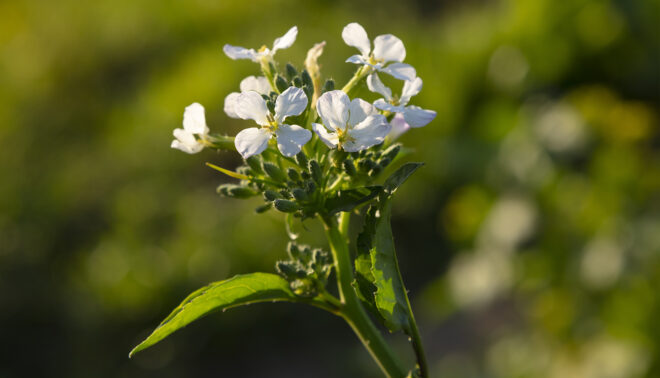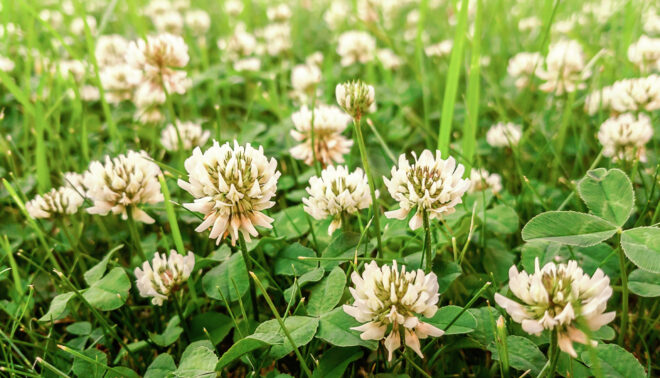The name itself doesn’t promise much … ‘catch crops’. It sounds like a supporting role, something which wouldn’t really be the focus of the action. But this is far from the case. In times of new fertiliser regulations, EU greening and increasingly difficult weather conditions in the wake of long-term climate change, it is precisely the breaks which grow between the main crops that are gaining enormous importance.
“They’ve come back again”, states Dr Christian Kleimeier from the Department of Crop Production, Plant Protection and Environment at the Schleswig-Holstein Chamber of Agriculture. “Knowledge of catch crops is old hat for agriculture as a whole. Textbooks from the 1920s, like Roemer and Scheffer’s ‘Ackerbaulehre’ (‘Arable Farming’), contain everything that is relevant today,” says Dr Kleimeier. For the chamber employee, there is no doubt that catch crops represent an important part of crop rotation.

Photo | privat
Catch crops are an important part of crop rotation.
Dr. Christian Kleimeier
This is a view that is now also shared by most farmers in Germany. Their demand for oil radish, phacelia, clover and the like is steadily increasing. This has also been noted by the seed breeders and suppliers. “For years now we have been recording an average annual increase in demand of around 5% for our catch crop mixtures,” reveals Jan Hendrik Schulz from Deutsche Saatveredelung AG (DSV), based in Lippstadt. DSV has been researching the field of catch crops for almost two decades and is considered one of the pioneers in this area. DSV’s intensive work and investment is reflected today in a wide range of blends: It now offers 20 specific mixtures, which, according to Mr Schulz, are constantly being improved and adapted.
Expertise for complex crop rotations
The firm’s expertise in complex crop rotations is based first and foremost on the fact that it has been dealing with agricultural species and varieties for almost 100 years. It is certainly also an advantage that the areas of breeding, research, production, sales and advisory services are all covered in-house.
At the end of the day, the composition of an ideal catch crop is the greatest challenge among many: “This is because biology, nutrient balance and soil structure should be optimal for the following main crop,” explains Mr Schulz. “For this, we need comprehensive species knowledge both in relation to the main crops and the catch crop species, as the interaction of the plants plays a crucial role.”

Photo | Deutsche Saatveredelung AG (DSV)
The interaction between the main crop and the catch crop plays a crucial role in their selection.
Jan Hendrik Schulz
Mr Schulz is convinced that the changing climate will also contribute to a lasting change in crop rotations. In this context, he speaks of a ‘key function’ that catch crops will have in crop rotations of the future, because they are able to control soil temperature and positively influence water management.
Water management is also important in the Thuringian Basin in Germany, a region with some very good soils, but with relatively low average precipitation of 480-530mm. Compared to northern Germany, this is a dry area. And in the extreme year of 2018, no more than 380mm fell there. “In such stress situations, good soil life is important for yield formation,” emphasises scientist Dr Steffi Knoblauch, pointing out the interrelation between soil biology and intercropping.
She has been conducting research on this topic at the Thuringian State Office for Agriculture and Rural Areas for many years, based at the trial fields in Buttelstedt. Among other things, she works with lysimeters, collecting exciting data on crop water consumption and soil water-holding capacity.
“I have found that farmers are definitely very concerned about soil fertility,” says Dr Knoblauch. She sees a growing awareness for this most important production factor, markedly in organic farming, but also with many conventional farmers. And from their perspective, healthy arable soil is hardly possible without a permanent activation of soil life. And since everything is interrelated, Dr Knoblauch is quickly back to the topic of catch crops. “The root mass of catch crops provides fodder for soil organisms,” she emphasises.
This in turn generates humus, adds organic material and stores carbon in the soil. In the spirit of active climate protection such methods are already practised by those involved in regenerative agriculture. The level of humus build-up which catch crops provide depends on the height of the plant cover and the type and duration of the greening. According to Dr Knoblauch, the LUFA (Agricultural Analytics and Research Center) provides practising farmers with specific information on humus balancing.
Same attention for the catch crop as for the main crop
However, cover cropping is a complex matter which requires a lot of knowledge on the part of the practitioner. Which species are even compatible with the main crops? For example, cultivating cruciferous crops like mustard or deep radish would be fatal for oilseed rape. The transmission of diseases is also an important aspect which must be taken into account when selecting the right mixture. Carelessness is often punished immediately, Dr Knoblauch warns, “so the catch crop must be treated with the same attention as a main crop.” This is not always easy, especially when time pressure during harvest is enormous and attention to detail can slip.
In dry areas, the catch crop’s water requirement should not be underestimated. Moisture losses can be significantly reduced at sowing by leaving straw on the field and direct sowing with a strip-till drill. Even so, farmers should take care, because an average catch crop yield of 12t fresh mass per hectare requires 30mm of precipitation during the growing season.

Photo | privat
The root mass of catch crops provides fodder for soil organisms.
Dr. Steffi Knoblauch
Even in more rainfall-privileged locations like Lower Saxony, Mecklenburg-Western Pomerania or Schleswig-Holstein, it has been observed that tight crop rotations mean the yields once achieved are no longer being attained. “After all, we have to think about how we feed the soil again and not just the plant,” says Dr Kleimeier, crop cultivation expert at the Schleswig-Holstein Chamber of Agriculture, who is backing a return to a broader crop rotation. In fact, the field bean, for example, has made a comeback which could hardly have been expected just a few years ago. The legume is now being grown again as a main crop on an impressive 10,000ha.
In any case, it’s best to move toward evergreen crop rotations, says Mr Schulz. ‘We are seeing a clear trend towards this due to climate change and political decisions.” In addition, the fertiliser ordinance prohibits fertilisation of cover crops in the so-called ‘red zones’. In Mr Schulz’s view, it is therefore important in these regions to keep nutrients in the soil in a sensible way and to use them.
Legumes and assessment of the carbon-nitrogen ratio play a key role here. “Only through targeted nutrient and plant management are we able to reduce the use of mineral fertilisers and achieve high yields and quality. Catch crops thus play a major role in the red zones.” So there will probably be flowering landscapes in Vechta, Bordesholm or at Franconian locations in the future.
Frequently grown catch crops

- Oil radish
- Phacelia
- Black oats
- Oil linseed
- Clover (alexandrine, stone, boxer, red clover)
- Alfalfa
- Vetches
- Field peas (cowpeas)
- Buckwheat
- Ramtilla




